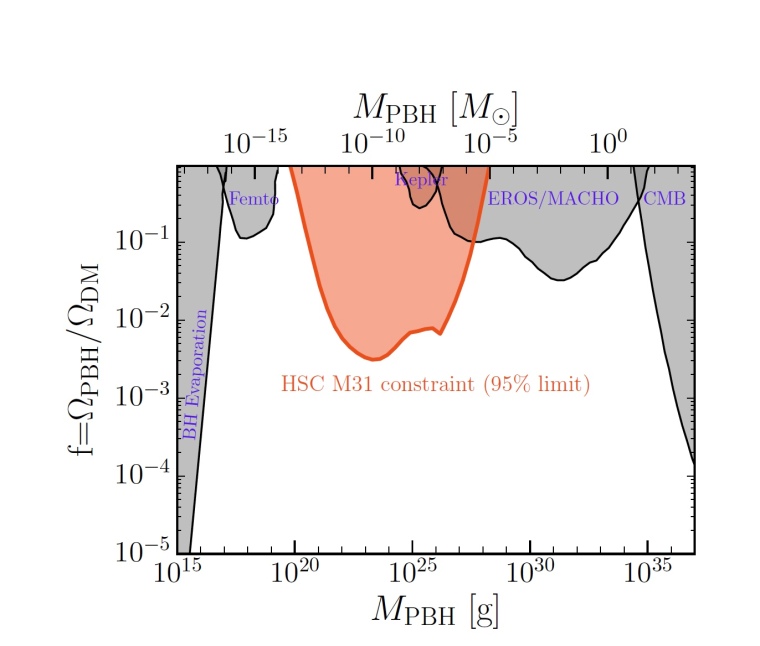Based on observed gravitational interactions in galactic halos (galaxy rotation curves) and in group and clusters, there appears to be 5 times as much dark matter as ordinary matter in the universe. The alternative is no dark matter, but more gravity than expected at low accelerations, as discussed in this post on emergent gravity.
The main candidates for dark matter are exotic, undiscovered particles such as WIMPs (weakly interacting massive particles) and axions. Experiments attempting direct detection for these have repeatedly come up short.
The non-particle alternative category is MACHOs (massive compact halo objects) composed of ordinary matter. Planets, dwarf stars and neutron stars have been ruled out by various observational signatures. The one ordinary matter possibility that has remained viable is that of black holes, and in particular black holes with much less than the mass of the Sun.
The only known possibility for such low mass black holes is that of primordial black holes (PBHs) formed in the earliest moments of the Big Bang.
Gravitational microlensing, or microlensing for short, seeks to detect PBHs by their general relativistic gravitational effect on starlight. MACHO and EROS were experiments to monitor stars in the Large Magellanic Cloud. These were able to place limits on the abundance of PBHs with masses from about one hundred millionth of a the Sun’s mass up to 10 solar masses. PBHs from that mass range are not able to explain the total amount of dark matter determined from gravitational interactions.
LIGO has recently detected several merging black holes in the tens of solar mass range. However the frequency of LIGO detections appears too low by two orders of magnitude to explain the amount of gravitationally detected dark matter. PBHs in this mass range are also constrained by cosmic microwave background observations.
Extremely low mass PBHs, below 10 billion tons, cannot survive until the present epoch of the universe. This is due to Hawking radiation. Black holes evaporate due to their quantum nature. Solar mass black holes have an extremely long lifetime against evaporation. But very low mass black holes will evaporate in billions of years or much sooner, depending on mass.
The remaining mass window for possible PBH, in sufficient amount to explain dark matter, is from about 10 trillion ton objects up to those with ten millionths of the Sun’s mass.

Figure 5 from H. Niikura et al. “Microlensing constraints on primordial black holes with the Subaru/HSC Andromeda observation”, https://arxiv.org/abs/1701.02151
Here f is the fraction of dark matter which can be explained by PBHs. The red shaded area is excluded by the authors observations and analysis of Andromeda Galaxy data. This rules out masses above 100 trillion tons and below a hundred thousandth of the Sun’s mass. (Solar mass units used above and grams are used below).
Now, a team of Japanese astronomers have used the Subaru telescope on the Big Island of Hawaii (operated by Japan’s national observatory) to determine constraints on PBHs by observing millions of stars in the Andromeda Galaxy.
The idea is that a candidate PBH would pass in front of the line of sight to the star, acting as a lens, and magnifying the light from the star in question for a relatively brief period of time. The astronomers looked for stars exhibiting variability in their light intensity.
With only a single nights’ data they made repeated short exposures and were able to pick out over 15,000 stars in Andromeda exhibiting such variable light intensity. However, among these possible candidates, only a single one turned out to fit the characteristics expected for a PBH detection.
If PBHs in this mass range were sufficiently abundant to explain dark matter, then one would have expected of order one thousand events, and they saw nothing like this number. In summary, with 95% confidence, they are able to rule out PBHs as the main source of dark matter for the mass range from 100 trillion tons up to one hundred thousandth of the Sun’s mass.
The window for primordial black holes as the explanation for dark matter appears to be closing.

January 27th, 2019 at 7:01 pm
[…] have ruled out small black holes in the range of grams up to about 3 times the Earth’s mass. https://darkmatterdarkenergy.com/2017/12/07/primordial-black-holes-and-dark-matter has more […]
March 3rd, 2023 at 10:14 am
[…] I have written about the possibility of primordial black holes as the explanation for dark matter, and on the observational constraints around such a […]